GREENEVILLE – Three Tusculum University students preparing to become teachers recently supported future colleagues by presenting engaging, hands-on approaches to math instruction at a regional professional conference.
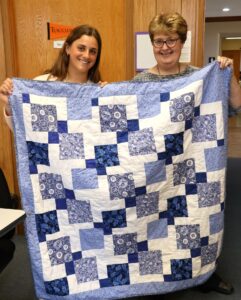
Student Sammy Jimenez, left, and Dr. Peggy Goodson-Rochelle, one of her professors, show the quilt.
Ellie Alvarez, a junior, and Caylen Conrad, a senior, who are pursuing bachelor’s degrees in elementary education K-5, showcased an approach to elementary mathematics instruction using the digital platform Brainingcamp. Sammy Jimenez, a junior, who is seeking the same degree, discussed using quilt-making to engage students in learning mathematical concepts.
The students made their presentations at Upper East Tennessee Council of Teachers of Mathematics meetings. Alvarez and Conrad discussed their topic at a virtual meeting, and Jimenez addressed the group in person on a different date. The meetings attracted teachers and administrators from Northeast Tennessee schools and other states.
“We are extremely proud of Ellie, Caylen and Sammy for this achievement in their development as teachers,” said Dr. Peggy Goodson-Rochelle, associate professor of education at Tusculum. “They are excellent students and are already impacting their classrooms as they develop their teaching skills. They have bright futures ahead of them as teachers, and we look forward to seeing their careers unfold.”
Alvarez and Conrad’s presentation
Alvarez and Conrad highlighted the integration of digital tools to enhance students’ engagement and conceptual understanding in mathematics. The virtual manipulatives, such as base 10 blocks, fraction bars and clocks, provide an interactive experience to support student learning.
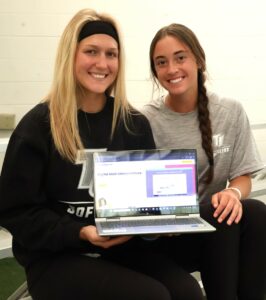
Caylen Conrad, left, and Ellie Alvarez show the Brainingcamp platform on a laptop.
During their session, the duo demonstrated how these tools can be seamlessly incorporated into lesson plans. This allows students to visualize mathematical concepts and engage in hands-on problem-solving activities. Alvarez and Conrad’s approach emphasizes the importance of leveraging technology to create inclusive learning environments, particularly for K-5 learners.
“I enjoy teaching math because there are so many different manipulatives and strategies we can use to make learning engaging and fun,” Conrad said. “Through this meeting, I had the opportunity to learn more about presenting in a professional environment. I learned so much about Brainingcamp itself and creating a presentation that would be interesting and informative for other teachers.”
Brainingcamp is a suite of virtual interactive math manipulatives that uses traditional objects and more functional features for modeling and problem-solving. Dr. Goodson-Rochelle introduced the platform to her students in the course Teaching Mathematics to K-5 Elementary Students.
For their presentation, Alvarez and Conrad liked sharing their love of teaching and spreading knowledge.
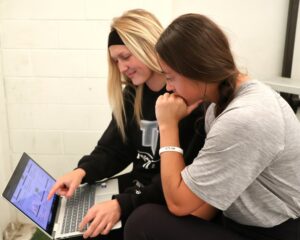
Caylen Conrad, left, and Ellie Alvarez look at the Brainingcamp platform they discussed in their presentation.
“This was a platform that not all teachers have heard about, so it was really rewarding to see how excited they got,” Alvarez said. “I enjoyed being able to answer their questions and brainstorm ways that they could use this in their classrooms.”
Conrad and Alvarez completed their clinicals, the first stage of teaching while in college, in kindergarten and fourth grade, respectively, at Hal Henard Elementary School in Greeneville. Alvarez explained the benefit of teaching.
“There’s something incredibly rewarding about helping students grow, whether it is by guiding them through a tough concept or watching their confidence build as they master new skills,” she said. “I also love the creativity involved in finding new ways to engage students and make learning fun. Seeing them succeed and knowing I played a role in that growth is what makes teaching so fulfilling.”
Jimenez’s presentation
Quilting is well-known for producing delightful coverings to keep people warm, but Jimenez discovered another practical application that increases learning in the classroom.
“Dr. Rochelle asked me whether I wanted to present at this conference, and she came up with the idea of creating a math quilt,” Jimenez said. “I was thinking of teaching about a math manipulative that we were learning in class, but then she gave me this idea and I thought, ‘This would be a lot more fun.’”
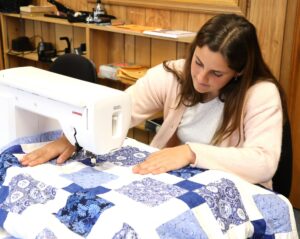
Sammy Jimenez demonstrates how she created the quilt.
After Jimenez’s proposal was accepted for presentation, Dr. Goodson-Rochelle brought sewing machines to the education building. Jimenez went in a couple days a week to make the quilt.
Jimenez showed the region’s educators how quilt-making can engage students in learning mathematical concepts, such as counting, basic math calculation, the distributive property, measurement, fractions, Fibonacci sequence, Pascal’s triangle, The Pythagorean Theorem and many other aspects of geometry.
This teaching strategy also facilitates content instruction in other subjects, including history, social studies and language arts. Jimenez loves math, but she also thoroughly enjoys social studies, so she inserted in her presentation a history of quilts, including how women used them to make statements and deploy them for political expression.
Jimenez enjoyed herself as she worked on the quilt because she likes hands-on activities and knows they make learning meaningful for students. That approach to education connects prior knowledge, incorporates problem-solving and higher-order thinking skills and cements the learning into long-term memory. Learning this way also makes math more fun, she said.
“I’m kind of a nerd when it comes to school, so I really enjoyed all of the research behind this project,” Jimenez said. “Dr. Goodson-Rochelle made it super exciting, too, because she kept showing me the different ways to look at the quilt. It was cool to see that you can take any concept and pull math out of it.”
Jimenez had never quilted before she started this project and said she is not artistic by nature, so this assignment was outside her comfort zone. She credits Dr. Rochelle with making the task relatively easy to accomplish.
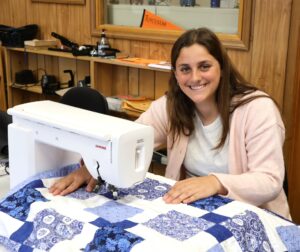
Sammy Jimenez sits with her quilt.
As a result of this project, Jimenez understands that math exists everywhere, a message she can share with her students. Completing the quilt has opened a new world for her as a teacher. She hopes to use one as a teaching method when she leads her own classroom.
“We talk in class all the time about the different types of teachers you can be,” Jimenez said. “There are some more old-fashioned people, and I think I fit that mold in some ways. But seeing that I can do these things is making me not so afraid to try different approaches, especially being in first grade for my clinical at Hal Henard, where I have to be a little craftier and hands-on, because their attention spans are shorter. Making this quilt has helped me a ton.”
Dr. Rochelle is thrilled Alvarez, Conrad and Jimenez could present to professional educators.
“Their participation underscores Tusculum University’s commitment to preparing educators who are adept at utilizing innovative tools to enhance the learning outcomes,” Dr. Goodson-Rochelle said. “As educational landscapes continue to evolve, such initiatives play a crucial role in equipping teachers with the skills necessary to meet the diverse needs of their students. K-5 students will be in good hands with Ellie, Caylen and Sammy as classroom teachers.“
Additional information about Tusculum’s teacher education program is available at https://site.tusculum.edu/bachelor-of-arts-in-interdisciplinary-studies/. To learn more about the university, please visit www.tusculum.edu.


